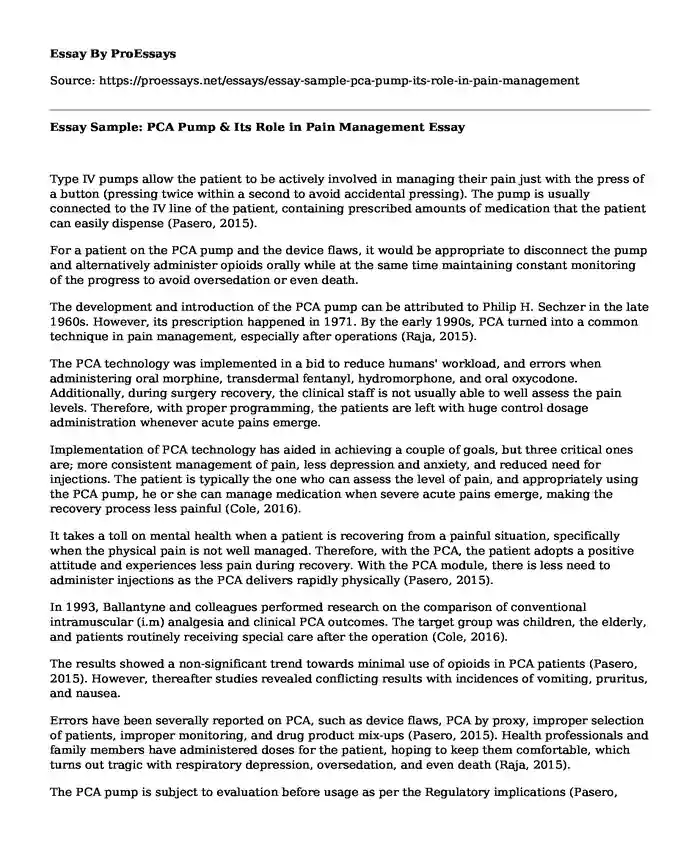Type IV pumps allow the patient to be actively involved in managing their pain just with the press of a button (pressing twice within a second to avoid accidental pressing). The pump is usually connected to the IV line of the patient, containing prescribed amounts of medication that the patient can easily dispense (Pasero, 2015).
For a patient on the PCA pump and the device flaws, it would be appropriate to disconnect the pump and alternatively administer opioids orally while at the same time maintaining constant monitoring of the progress to avoid oversedation or even death.
The development and introduction of the PCA pump can be attributed to Philip H. Sechzer in the late 1960s. However, its prescription happened in 1971. By the early 1990s, PCA turned into a common technique in pain management, especially after operations (Raja, 2015).
The PCA technology was implemented in a bid to reduce humans' workload, and errors when administering oral morphine, transdermal fentanyl, hydromorphone, and oral oxycodone. Additionally, during surgery recovery, the clinical staff is not usually able to well assess the pain levels. Therefore, with proper programming, the patients are left with huge control dosage administration whenever acute pains emerge.
Implementation of PCA technology has aided in achieving a couple of goals, but three critical ones are; more consistent management of pain, less depression and anxiety, and reduced need for injections. The patient is typically the one who can assess the level of pain, and appropriately using the PCA pump, he or she can manage medication when severe acute pains emerge, making the recovery process less painful (Cole, 2016).
It takes a toll on mental health when a patient is recovering from a painful situation, specifically when the physical pain is not well managed. Therefore, with the PCA, the patient adopts a positive attitude and experiences less pain during recovery. With the PCA module, there is less need to administer injections as the PCA delivers rapidly physically (Pasero, 2015).
In 1993, Ballantyne and colleagues performed research on the comparison of conventional intramuscular (i.m) analgesia and clinical PCA outcomes. The target group was children, the elderly, and patients routinely receiving special care after the operation (Cole, 2016).
The results showed a non-significant trend towards minimal use of opioids in PCA patients (Pasero, 2015). However, thereafter studies revealed conflicting results with incidences of vomiting, pruritus, and nausea.
Errors have been severally reported on PCA, such as device flaws, PCA by proxy, improper selection of patients, improper monitoring, and drug product mix-ups (Pasero, 2015). Health professionals and family members have administered doses for the patient, hoping to keep them comfortable, which turns out tragic with respiratory depression, oversedation, and even death (Raja, 2015).
The PCA pump is subject to evaluation before usage as per the Regulatory implications (Pasero, 2015). Among other standards, it should be easy to program and deliver desired concentrations. The opiate default settings should be adjustable, limited to a single model for proficiency purposes in programming, and a warming button "For Patient Use Only" be placed on the activation button.
It would be appropriate for the clinical personnel to receive adequate training on how to administer the drug to avoid drug product mix-ups, properly monitor patients, and carefully select patients with physical, cognitive, and mental alertness to be attached to the PCA pump as it is neither "set and forget" or "one size fits all" to achieve most effective results.
References
Cole, P. (2016). Oliceridine. mu-Opioid receptor ligand, Treatment of moderate to severe acute pain. Drugs of the Future, 41(6), 347.Pasero, C. (2015). Unconventional Use of a PCA Pump: Nurse-Activated Dosing. Journal of PeriAnesthesia Nursing, 30(1), 68–70. https://doi.org/10.1016/j.jopan.2014.11.004
Raja, S. (2015). Off-pump versus on-pump coronary artery bypass grafting: comparative effectiveness. Comparative Effectiveness Research, 73. https://doi.org/10.2147/cer.s62637
Cite this page
Essay Sample: PCA Pump & Its Role in Pain Management. (2023, Nov 03). Retrieved from https://proessays.net/essays/essay-sample-pca-pump-its-role-in-pain-management
If you are the original author of this essay and no longer wish to have it published on the ProEssays website, please click below to request its removal:
- The Outbreak of Yellow Fever In Angola
- Course Work Sample: Discussion on Postnatal Maternity Nurse Care
- The Health Effects of Smoking Bans Essay
- The Scale of America's Opioid Epidemic Is Shocking
- Essay Example on Social Location: Impact on a Social Worker in Stamford Hill
- Essay Example on US Health Management: Ensuring Sustainable Care
- Understanding Varicose Vein Problems - Free Report Example







